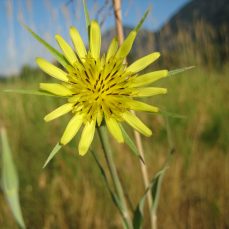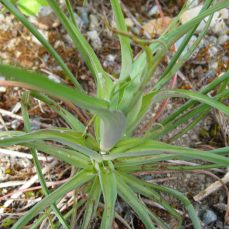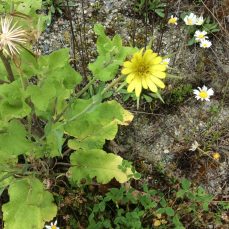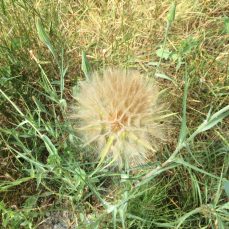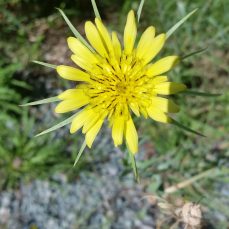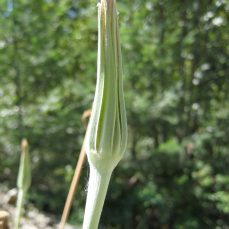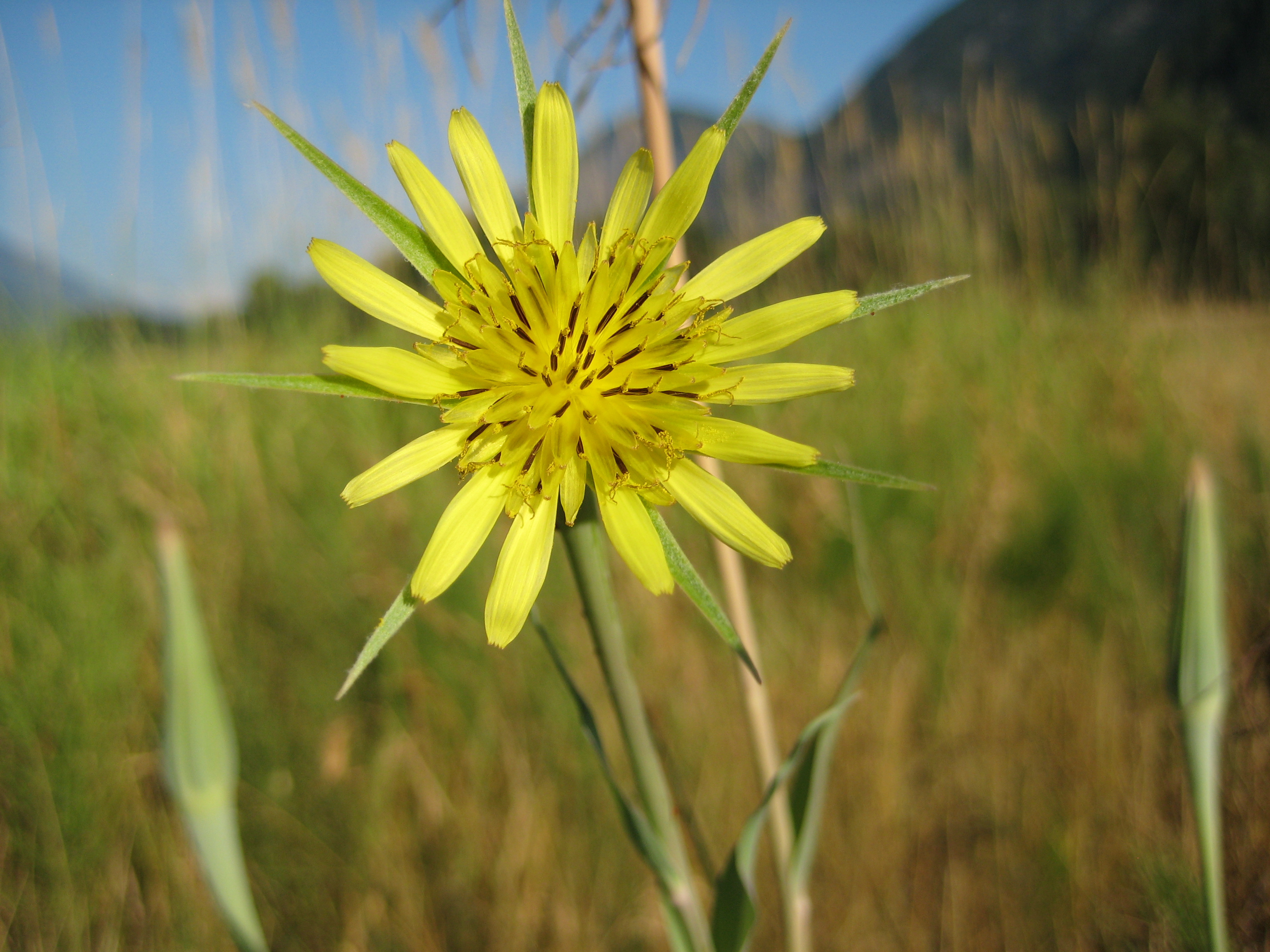
Management Category
Squamish
Whistler
Pemberton
Vectors of Spread
Synonyms
- Western goat’s beard
- Western salsify
- Giant dandelion
Similar Species
Invasive
Perennial sow thistle (Sonchus arvensis) is a far-creeping perennial plant that more closely resembles giant dandelions than it does true thistles. Its leaves are various shapes, alternate, waxy, and have weakly prickled edges. In comparison, yellow salsify’s leaves are longer and more grass-like.

Photo credit: Tom Heutte, USDA Forest Service, Bugwood.org
Annual sow thistle (Sonchus oleraceus L.) closely resembles perennial sow thistle. It’s distinguished by a much shorter taproot system.

Native
Canadian hawkweed (Hieracium canadense) is native to North America. The pointed leaves have toothed margins that appear hooked.

ID Characteristics
Flowers: Are pale yellow and consist of numerous ray florets. The flowers have approximately 13 thin flower bracts that are roughly the same colour as the stems and leaves. Flower heads open in the morning and close midday.
Stems: Are round and hairy, 0.3 – 1 m tall. Both the stems and the leaves are a pale greyish green or bluish green, and exude a milky white latex when broken.
Leaves: Are long and grass-like with crisp margins and a triangular structure. The 3 cm-long leaves have parallel venation and clasp the stem at their base. They are hairy and their edges are smooth.
Roots: Yellow salsify’s fleshy taproot which can be eaten raw (taste like oysters), or ground and roasted as a coffee substitute.
Seeds: Are globe-shaped and fluffy, like large dandelions (5 – 10 cm across). They are usually white towards the base and tawny brown towards the tips.
Habitat and Origin
Yellow salsify is native to Europe and North Africa. It was brought to North America around 1900 as a food source and ornamental plant.
Yellow salsify prefers full sun, moderately dry conditions, and poor soil, like sand, clay or gravel. However, it will also grow in fertile loam, where it will become taller. Yellow salsify can be found in open areas.
How it Spreads
Yellow salsify reproduces by seed. It can either be pollinated by insects or self-pollinate. This species is hermaphrodite (flowers have both male and female organs). One plant can produce 1,000 seeds, which the wind can disperse great distances.
Yellow salsify is a monocarpic perennial, which means that it dies after it sets seed. It usually flowers after 2- 4 years, but this delay can be up to 14 years long.
The tall stalks, lightweight seeds, and parachute-like pappus (cluster of hairs) help spread the seeds in the wind. Yellow salsify can also be spread in contaminated soil.
Impacts
Ecological:
- Creates a new layer in sparse, herbaceous habitats, displacing native forb and grass species.
Economic:
- Decreases forage production because yellow salsify is inedible to most grazers.
Prevent the Spread
Yellow salsify is widespread in the Sea to Sky region, and site-scale control options are either ineffective or futile. While yellow salsify is not included in SSISC’s control programs, we recommend that its cultivation be avoided.
Learn to identify yellow salsify: use the images presented on this page to learn how to identify yellow salsify.
What to do if you spot it: You can report any yellow salsify sighting by clicking here.
DO:
- Regularly monitor properties for weed infestations.
- Ensure soil and gravel are uncontaminated before transport.
- Check wildflower mixes to ensure that they do not contain yellow salsify.
- Ensure that plants are disposed of in a garbage bag if found in floral arrangements to prevent seeds from spreading.
DO NOT:
- Do not unload, park or store equipment or vehicles in infested areas; remove plant material from any equipment, vehicles or clothing used in such areas and wash equipment and vehicles at designated cleaning sites before leaving infested areas.
- Do not plant yellow salsify in a garden, no matter how well-contained its enclosure may seem.
- Do not move soil that has been contaminated with yellow salsify.
- Do not compost!
Control
Mechanical
- Hand-pull rosettes as soon as they appear; older plants are more difficult to pull because of their taproot.
- Mature plants will likely grow back if the plant is broken off before the top 10 cm of the root can be removed.
- Tillage in the spring or fall eliminates all existing plants, as long as it’s done deeply enough.
- Avoid mowing yellow salsify, as it has no positive effect on its control.
Chemical
- Dicamba, metsulfuron methyl + aminopyralid, chlorsulfuron + metsulfuron methyl, 2,4-D + dicamba or metsulfuron methyl alone have proven effective on yellow salsify.
- Picloram has also been proven effective, however it is not suitable for wet, coastal soils.
- We recommend that any herbicide application is carried out by a person holding a valid BC Pesticide Applicator Certificate. Before selecting and applying herbicides, you must review and follow herbicide labels and application rates; municipal, regional, provincial and federal laws and regulations; species-specific treatment recommendations, and site-specific goals and objectives.
Biological
There is no biocontrol available for this plant.
Sea to Sky Distribution
Yellow Salsify Factsheet
Having trouble viewing the factsheet? Don’t worry, all the information is included on this page. You can also contact us with any questions.
References
- Alaska Natural Heritage Program
- Bonneville County (Idaho), Western Salsify
- Clemens, David R.; Upadhyaya, Mahesh K.; Bos, Shelley J., “The biology of Canadian weeds 110: Tragopogon dubius Scop., Tragopogon pratensis L., and Tragopogon porrifolius L.”, in Canadian Science Publishing
- Illinois Wildflowers, Western Goat’s Beard
- iNaturalist, Yellow Salsify
- Invasive Plant Atlas of the United States, Western Salsify
- Mangold, J. and Lansverk, A. L., “Testing Control Options for Western Salsify (Tragopogon dubius) on Conservation Reserve Program Lands”, in Weed Technology 27(3)
- Mangold, J. and Lansverk, A. L., Westen Salsify, Montana State University Extension MontGuide
- Native Plant Trust, Tragopogon dubius
- Northern Bushcraft, Salsify
- Northwest Invasive Plant Council, Tragopogon Identification and Control
- Plants for a Future, Tragopogon dubius
- Stevens County Noxious Weed Control Board, Western Salsify (Tragopogon dubius)
- United States Department of Agriculture, Natural Resources Conservation Service, Tragopogon dubius
- University of Wisconsin – Madison, Wisconsin Horticulture Division of Extension, Yellow Goatsbeard, Tragopogon spp.





